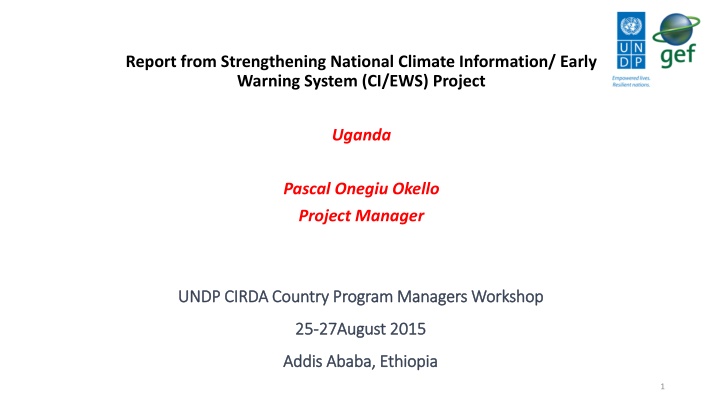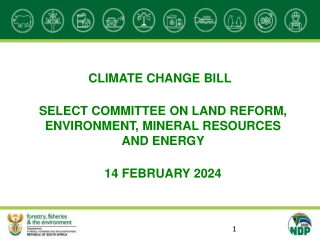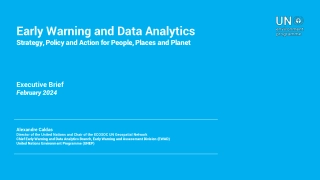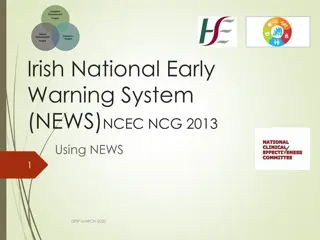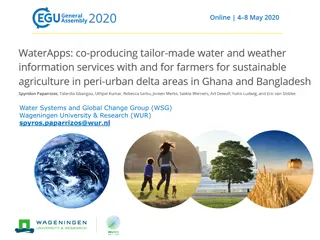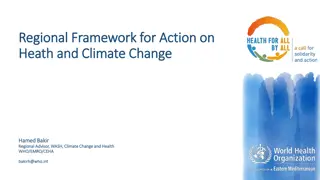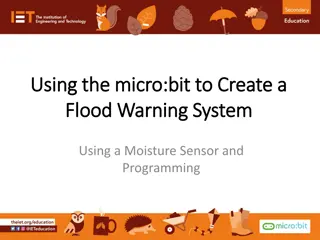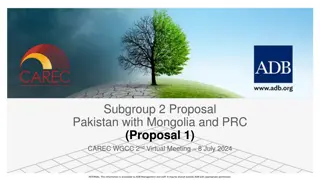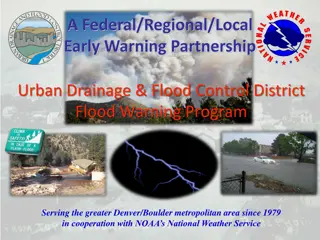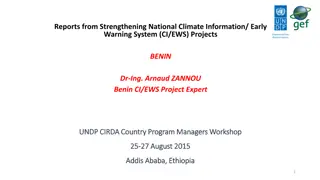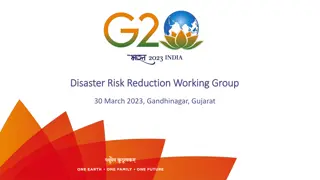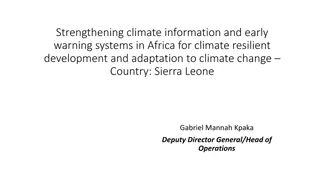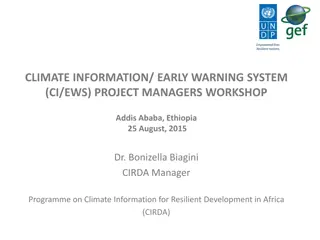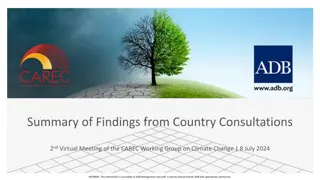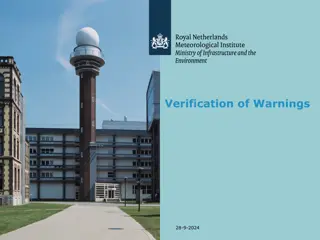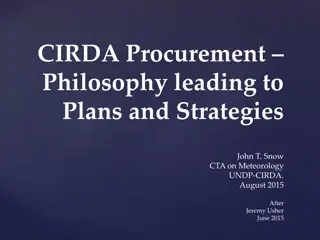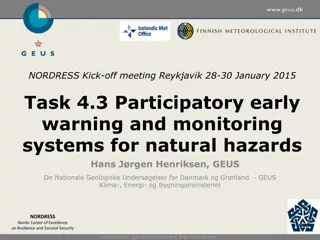Strengthening National Climate Information & Early Warning System Project in Uganda
Strengthening National Climate Information/Early Warning System (CI/EWS) Project in Uganda aims to enhance weather, climate, and hydrological monitoring capabilities to respond to extreme weather and plan climate change adaptation. The project involves key partners, organizational structure, progress updates, challenges, and future plans for CIRDA. Various stakeholders like UNDP, UNMA, OPM, MAAIF, and others contribute to the project's success.
Download Presentation

Please find below an Image/Link to download the presentation.
The content on the website is provided AS IS for your information and personal use only. It may not be sold, licensed, or shared on other websites without obtaining consent from the author.If you encounter any issues during the download, it is possible that the publisher has removed the file from their server.
You are allowed to download the files provided on this website for personal or commercial use, subject to the condition that they are used lawfully. All files are the property of their respective owners.
The content on the website is provided AS IS for your information and personal use only. It may not be sold, licensed, or shared on other websites without obtaining consent from the author.
E N D
Presentation Transcript
Report from Strengthening National Climate Information/ Early Warning System (CI/EWS) Project Uganda Pascal Onegiu Okello Project Manager UNDP CIRDA Country Program Managers Workshop UNDP CIRDA Country Program Managers Workshop 25 25- -27August 2015 27August 2015 Addis Ababa, Ethiopia Addis Ababa, Ethiopia 1
Content: Content: Introduction Organizational Structure Role of Key Partners Progress to date Opportunities & Challenges Future plans for CIRDA Conclusion 2
The Delegates: The Delegates: 1. 1. Khalid Muwembe; Director Forecasting Khalid Muwembe; Director Forecasting- -UNMA; UNMA; 2. 2. Onesimus Muhwezi; TL Energy & Env Onesimus Muhwezi; TL Energy & Env- -UNDP CO; UNDP CO; 3. 3. Pascal Onegiu Okello; PM Pascal Onegiu Okello; PM- -SCIEWS Project; SCIEWS Project; 4. 4. Jennifer Kiiza; FAA Jennifer Kiiza; FAA- -SCIEWS Project SCIEWS Project 3
Introduction: Introduction: Overall objective: To strengthen the weather, climate and hydrological monitoring capabilities, EWSs and available information for responding to extreme weather and planning adaptation to climate change in Uganda. Changing implementation frameworks: Global: Sustainable Development Goals; National: New National Development Plan (2016-2020); Country Office: Country Programme Document(2016-2020) 4
Project Organisation Structure Project Board Executive: Senior Supplier: UNDP Senior Beneficiary/ies: MWE, OPM, MAAIF MWE Project Manager Project Support Admin/Financial officer; Procurement Associate Project Assurance UNDP (CO & UNDP GEF) Technical and implementation support: UNMA,DWRM,DRDPM,MAAIF,DLGs,UCC,MoFP ED, CSOs and the Private Sector. 5
Contribution of Key Partners (IP/RPs): Contribution of Key Partners (IP/RPs): UNDP: Quality Assurance UNMA: Lead IP; Weather forecasting; Aviation briefing; DWRM: Water level monitoring & CbWRM structures OPM: NECOC/Dissemination of EW; Disaster Mgmt; MAAIF: Extension/outreach services MoLG: Sub-National linkage (DDMCs) UCC: Oversight & Coordination of Telecommunications service providers MoFPED: Focal Point for GEF Projects 6
PROGRESS TO DATE: PROGRESS TO DATE: Outcome 1 Output Status Enhanced capacity of the UNMA and DWRM to monitor and forecast extreme weather, hydrology and climate change. Output 1.1: (16 new AWLS and repair of 45WLS) Proc.via UNDP CO; Evaluation stage Proc of AMSS @ evaluation stage; Output 1.2: (25 new AWSs and repair of 32 WSs) . Up to 30 AWSs via LTA and civil works via national contracting both at evaluation stages. Output 1.3 :Weather and climate forecasting facilities upgraded Output 1.4 : Capacity developed for operating and maintaining observation networks. Procured 270 new Thermometers; re-stocked upper air balloons & radiosondes for 1 year Accessing TA from KMS ; Protocol and MoU for UNMA/DWRM data sharing developed 7
CONTINUED: CONTINUED: Outcome 2 Efficient and effective use of hydro- meteorological and environmental information for making early warnings and LT development plans. Output Status Placed 5 UNMA staff at KMS; Trained 8 Hazard & Vulnerability mapping Formed sub-national EW Committees; M&E Framework in place Produced a Communications Strategy for UNMA Cost-Benefit & marketing strategies for UNMA in place; Output 2.1 :Technical capacity of UNMA and DWRM is strengthened through training. Output 2.2 :Tailored weather and climate info. developed and made accessible to users. Output 2.3: Weather and climate information mainstreamed into national policies, annual work plans and local development . Output 2.4 :Govt. and Non-Govt. communication channels and procedures for issuing alerts developed and in use. Output 2.5: Sustainable financing options identified, developed and implemented (for the operation and maintenance)/sustainability. 8
Opening of the March 2015 PPP UNDP/CIRDA Conference, Golf Course Hotel, Kampala. Hon. Minister of Water & Environment releases balloon to re-launches the upper air sounding service 9
Contribution to Key events(visibility): Contribution to Key events(visibility): CIRDA Public Private Partnership conference in Uganda-March,2015; World Meteorological Day March,2015; World Water Day-March 2015; World Environment Day- June 2015; A week long Agricultural show-July 2015; UNMA Stakeholders workshop May,2015; International Day for Disaster Reduction(October) 10
Opportunities: Opportunities: Political support for meteorological services; UNMA Act- a legal basis to exercise its mandate; UNMA has a new Management team that could bring in a new approach to doing business; Assessment Reports( MDA, Cost Benefit&Market) with options for improving income generation; Income generation through Govt., partnering with Telecommunications Companies & other private sector; 11
CHALLENGES: CHALLENGES: Programmatic: Balancing the status quo and need for innovation in technology transfer; Demand for high quality and reliable weather data; Poor visibility of UNMA(DoM) Operational: Transition from DoM to UNMA affected NIM hence request for services via UNDP; Delayed procurement affecting delivery (24% SCIEWS); 12
SOCIAL & ECONOMIC IMPACT: SOCIAL & ECONOMIC IMPACT: Nominal impact: Sectors: Aviation , agriculture, Water Resources , Desaster Mgmt; Media: radio, TV (UBC), web-site (courtesy of GiZ/USAID), cell phones; Generally a growing interest/value in meteorological products among population in disaster and hazards prone areas; The Sugar Corporations /plantations (Kinyara, Kakira) are two key business sectors interested in weather data; NECOC , MAAIF and CSOs are instrumental in dissemination of data downstream. 13
FUTURE PLANS: FUTURE PLANS: Integrating SCIEWS outcomes within the CPD 2016-2020 structure; Strengthening the District structures for utilizing meteorological products; Linking all weather stations to the NMC/AMSS; Increasing the density of AWSs (>200) using low price options and improving data quality and services; Developing applications: contents and packaging weather products for commercial use and the general public; 14
Is mounting AWSs on flats an option?? THANK YOU!! 15
